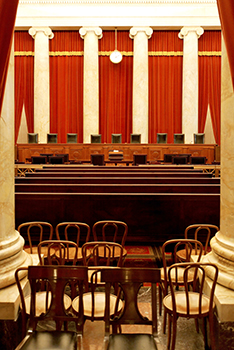 Aug. 6, 2014 – The dust has settled. The media frenzy is over. With the U.S. Supreme Court’s 2013 term in the rear-view mirror, now is a good time to review what happened, and what some national and local legal commentators had to say about it.
Aug. 6, 2014 – The dust has settled. The media frenzy is over. With the U.S. Supreme Court’s 2013 term in the rear-view mirror, now is a good time to review what happened, and what some national and local legal commentators had to say about it.
First, we turn to SCOTUS Blog’s final “Stat Pack for the 2013 Term.” It includes a mountain of statistical information about the high court’s work this term, which ran from October 2013 through June 2014. In all, the Court heard 73 cases on the merits.
Forty-eight (66 percent) of the merits cases were 9-0 decisions. Ten cases (the second-highest at 14 percent) resulted in a 5-4 decision, but only six of the 5-4 decisions resulted in a straight split between the so-called “liberal” and “conservative” justices.
Justice Anthony Kennedy was the swing vote in those six cases. In four of them, Justice Kennedy sided with the bloc of justices appointed by a Republican President: Chief Justice John Roberts (George W. Bush) and Justices Antonin Scalia (Ronald Reagan), Clarence Thomas (George H.W. Bush), and Samuel Alito (George W. Bush).
In two cases, Justice Kennedy (Ronald Reagan) sided with justices appointed by a Democratic President: Justices Ruth Bader Ginsburg (Bill Clinton), Stephen Breyer (Bill Clinton), Sonia Sotomayor (Barack Obama), and Elena Kagan (Barack Obama).
Four cases (5 percent) were on review from the Seventh Circuit Court of Appeals, which includes Wisconsin. The Court reviewed the most cases (12) from the Ninth Circuit Court of Appeals, which includes California and other western states. The Court heard eight cases (11 percent) on review from a state court, but none from Wisconsin.
The 9-0 Decisions
According to Georgetown Law Professor Neal Katyal, the Court delivered an historic percentage of unanimous 9-0 decisions, the highest percentage since 1940.
Writing for the New York Times, Katyal called the high number of unanimous decisions a “remarkable achievement” and evidence of “cultivated collegiality” among the justices, which can be characterized or perceived (rightly or wrongly) as motivated by ideology.
“The justices’ ability to cross partisan divides and find common ground in their bottom-line judgment in roughly two-thirds of their cases … should remind us that even in this hyperpartisan age, there is a difference between law and politics,” Katyal wrote.
But Harvard Law Professor Laurence Tribe, writing for Slate, notes that many 9-0 decisions still have concurring opinions with divergent views and unanimity, on the surface, can sometimes “mask deep divisions that emerge a few years later.”
 Joe Forward, Saint Louis Univ. School of Law 2010, is a legal writer for the State Bar of Wisconsin, Madison. He can be reached by email or by phone at (608) 250-6161.
Joe Forward, Saint Louis Univ. School of Law 2010, is a legal writer for the State Bar of Wisconsin, Madison. He can be reached by email or by phone at (608) 250-6161.
University of Chicago Law Professor Eric Posner, also writing for Slate, questioned Katyal’s assessment of the court’s perceived cohesiveness. “[E]ven when all nine justices agree on the outcome, that outcome can be – and likely is – determined by an ideologically driven compromise that takes place in the justices’ chambers.”
Posner suggests that a chief justice’s ability to “suppress the visible evidence of ideological disagreement” is a “tactical skill, to be sure, but nothing to celebrate.”
In any event, some of the higher profile 9-0 decisions this term included Riley v. California, McCullen v. Coakley, and National Labor Relations Board v. Canning.
In Riley v. California, the Court unanimously held that police, without a warrant, may not search digital information on cell phones seized from arrested individuals. Justice Alito filed a concurring opinion. Otherwise, all justices were in agreement in Riley.
“Riley gave the Court an opportunity to address criticisms that it is out of touch with modern technological realities,” wrote Marquette Law Professor Michael O’Hear in a blog post on the Marquette University Law School Faculty Blog.
“The Riley Court was able to demonstrate that it can pull its head out of the eighteenth century and adapt its constitutional jurisprudence so as to respond to distinctly twenty-first century concerns,” wrote O’Hear, analyzing the Court’s Fourth Amendment cases.
In McCullen v. Coakley, the Court unanimously struck down a Massachusetts law that made it a crime to stand on a public street or sidewalk within 35 feet of abortion clinics, which was the practice of some attempting to influence the decisions of patients.
This “buffer zone” violated the First Amendment, the Court ruled in a majority opinion by Chief Justice Roberts. However, Justice Scalia filed a concurring opinion, joined by Justices Kennedy and Thomas. Justice Alito also filed a concurring opinion.
“One potentially wider implication of the ruling is that it may also imperil ‘bubble zones’ near clinics – invisible no-entry zones that float around individual patients as they approach a clinic,” wrote Lyle Denniston for SCOTUS blog.
In National Labor Relations Board v. Canning, the Court ruled that President Obama violated the Recess Appointments Clause of the U.S. Constitution by appointing three commissioners to the NLRB during an “intra-session” recess of the U.S. Senate. In this case, the four “conservatives” joined together in a concurring opinion by Justice Scalia.
The 5-4 Decisions
Of the 73 merits cases, only 10 cases were decided by a 5-4 decision. This represents 14 percent of all decisions, the lowest percentage of 5-4 decisions since 2005. In addition, only six cases were decided as a split between so-called “conservatives” and “liberals,” grouped under the party affiliation of the president who appointed them.
Historically, 5-4 decisions draw high-profile attention from those who suspect that such splits represent the ideological divide among justices of the U.S. Supreme Court.
Last year, 16 of the Court’s 23 total 5-4 splits were decided on “party lines,” with Justice Kennedy siding with “conservatives” in 10 cases, and with “liberals” in six. This year, only a total of six cases were decided that way. But one Milwaukee lawyer suggests the conservative-liberal divide is less significant than the reasoning of each opinion.
“The significance of a 5-4 decision can turn on the strength and coherence of the reasoning which decides the close case,” says Michael Brennan, an appellate lawyer at Gass Weber Mullins LLC and a former circuit court judge in Milwaukee County.
“A 5-4 decision with splintered reasoning can have multiple justices writing concurring opinions as to why they decided the way they did. A slightly different case with a slightly different argument may yield a different result in the future,” Brennan said.
“Contrast that with a 5-4 decision grounded in solid reasoning shared among five justices, reasoning that beats out the alternatives. That produces an authoritative, workable rule for future cases, and is more respected,” Brennan continued.
Kennedy on the Right
Perhaps the most high-profile case of the 5-4 decisions was Burwell v. Hobby Lobby, in which the “conservative majority” (plus Kennedy) ruled that closely-held companies with religious owners cannot be compelled to offer health care coverage for contraceptives.
Marquette Law Professor Michael Waxman, in a Faculty Blog post, notes that the Hobby Lobby decision raises some unanswered questions about the interaction between the Religious Freedom Restoration Act and the Affordable Care Act (ACA).
“Considering the majority’s reliance on two terms that go undefined by the Court – ‘sincere religious belief’ and ‘closely held corporation … and the fact that none of the other Hobby Lobby opinions address the meaning of these terms, it is essential that these terms be defined as they fit into the ACA context,” Prof. Waxman wrote.
Another high-profile case was McCutcheon v. Federal Election Commission, in which the 5-4 conservative majority struck down monetary limits on aggregate contributions to federal election candidates, political campaigns, or political action committees.
Mike Wittenwyler, an administrative and regulatory attorney at Godfrey & Kahn S.C., explains McCutcheon and state campaign finance changes in his May InsideTrack article, “McCutcheon and Act 153 Affect Campaign Financing in Wisconsin.”
In Town of Greece v. Galloway, the conservative majority ruled that a town’s practice of holding prayers before town board meetings did not violate the Establishment Clause.
“Narrowly defining what is not allowed in such prayers, the Court said they may not be used to praise the virtues of one faith and may not cast other faiths or other believers in a sharply negative light,” wrote Lyle Denniston for SCOTUS blog.
And in Harris v. Quinn, the conservative majority held that public sector unions cannot collect “agency fees” from nonunion workers who are not full-fledged public employees.
Two law professors, writing for the New York Times, said the decision was narrow, but “saying that, in some cases, unions could not collect fees from one particular class of public employees who did not want to join, its language suggests that this may be the court’s first step toward nationalizing the ‘right to work’ gospel by embedding it in constitutional law,” wrote Cynthia Estlund (NYU) and William Forbath (Texas).
Kennedy on the Left
The liberal majority (liberals plus Kennedy) took 5-4 decisions in Hall v. Florida and Abramski v. United States. In Hall, the majority said Florida could not execute people who don’t have intellectual disabilities, as determined solely by a threshold IQ score.
In Abramski, the liberal majority held that a person violates federal law if purchasing a gun on someone else’s behalf but not claiming so on a federal gun purchase form. The dissenting opinion from the conservative justices argued that a federal background check doesn’t apply if the purchaser and transferee are legally eligible to buy a gun.
“Statutory cases are not marked by the rigid ideological divides that we see in some areas of constitutional criminal law, such as the Eighth Amendment,” O’Hear wrote.
“Only Abramski featured the classic 5-4 ideological breakdown – perhaps a reflection of the especially ideologically charged nature of gun-ownership issues.”
Other Notable 5-4 Decisions
In Navarette v. California, Justice Thomas wrote a majority opinion, joined by Chief Justice Roberts and Justices Kennedy, Breyer, and Alito to uphold the marijuana possession convictions of two brothers who were pulled over and searched by police after 911 dispatchers received an anonymous tip about their erratic driving.
The tipster had provided the license plate of the vehicle driven by the defendants and said they had run her off the road. This was enough, the majority ruled, for police to believe that the driver was drunk. Thus, the majority said the traffic stop was legal.
“The 5-4 lineup mirrors that in Maryland v. King, another Fourth Amendment decision from last term that reflects the differing world view of the majority and dissent as to whether (and how) the Fourth Amendment applies to citizen-police encounters,” said Marcus Berghahn, a criminal lawyer at Hurley, Burish & Stanton in Madison.
In Paroline v. United States, Justice Kennedy (author) and Justices Breyer, Kagan, Ginsburg, and Alito, ruled that a child pornography defendant, under federal law, must only pay mandatory restitution for losses proximately caused by the defendant.
“The real mystery in Paroline is why the liberals switched sides and supported a more expansive approach to liability in a criminal case, Professor O’Hear wrote in a blog post.
